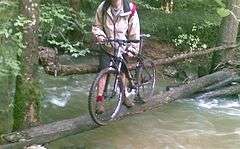Log bridge
|
Simple log bridge over the Alzou in France | |
| Ancestor | Step-stone bridge |
|---|---|
| Related | Clapper bridge |
| Descendant | Beam bridge |
| Carries | Pedestrians, vehicles (on multiple parallel logs) |
| Span range | Short |
| Material | Logs, dry set stonework footings, top may be flattened or boards added, topped with rammed earth for vehicles |
| Movable | No |
| Design effort | Low |
| Falsework required | No |
A log bridge is a timber bridge that uses logs[1] that fall naturally or are intentionally felled or placed across streams. The first man-made bridges with significant span were probably intentionally felled trees.[2]
The use of emplaced logs is now sometimes used in temporary bridges used for logging roads, where a forest tract is to be harvested and the road then abandoned. Such log bridges have a severely limited lifetime[3] due to soil contact and subsequent rot and wood-eating insect infestation.
Longer lasting log bridges may be constructed by using treated logs and/or by providing well drained footings[4] of stone or concrete combined with regular maintenance to prevent soil infiltration. This care in construction can be seen in the French bridge illustrated below, which has well locked dry set stone abutments and a footpath leveled with boards.
Various log bridge designs
 Log bridge over a river in Papua New Guinea
Log bridge over a river in Papua New Guinea Log bridge in Zaire, made of multiple parallel logs
Log bridge in Zaire, made of multiple parallel logs Log bridge over the Nisqually River, United States, made of one large log with handrail
Log bridge over the Nisqually River, United States, made of one large log with handrail- Log bridge in Switzerland with flattened top and handrail
- Log bridge in Slovakia with additional boards on top
 Log bridge in Slovakia with additional logs laid crosswise (a beam bridge)
Log bridge in Slovakia with additional logs laid crosswise (a beam bridge) Log bridge in France with dry set stone abutments and a footpath leveled with boards
Log bridge in France with dry set stone abutments and a footpath leveled with boards- Complex Tibetan log bridge made of multiple logs (a cantilever bridge)
External links
![]() Media related to Log bridges at Wikimedia Commons
Media related to Log bridges at Wikimedia Commons
References
- ↑ National Parks Conference, Department of the Interior (1915). Proceedings of the National parks conference held at Berkeley, California March 11, 12, and 13, 1915. Washington: Government Printing Office. p. 60. Retrieved March 14, 2010.
(A log bridge) is a bridge composed of log beams, the logs being in natural condition or hewn, which are thrown across two abutments, and over which traffic may pass.
- ↑ Bennett, David (2000). "The history and development of bridges". In Ryall, M. J.; Parke, G.A.R.; Harding, J.E. The manual of bridge engineering (Google books). London: Thomas Telford. p. 1. ISBN 978-0-7277-2774-9. Retrieved March 14, 2010.
- ↑ National Parks Conference 1915, p. 59. "The chief objection to a log bridge ... is the shortness of its life."
- ↑ National Parks Conference 1915, p. 59. "If we can design the abutment so that no moisture can collect under the logs the life of the bridge is materially increased."
